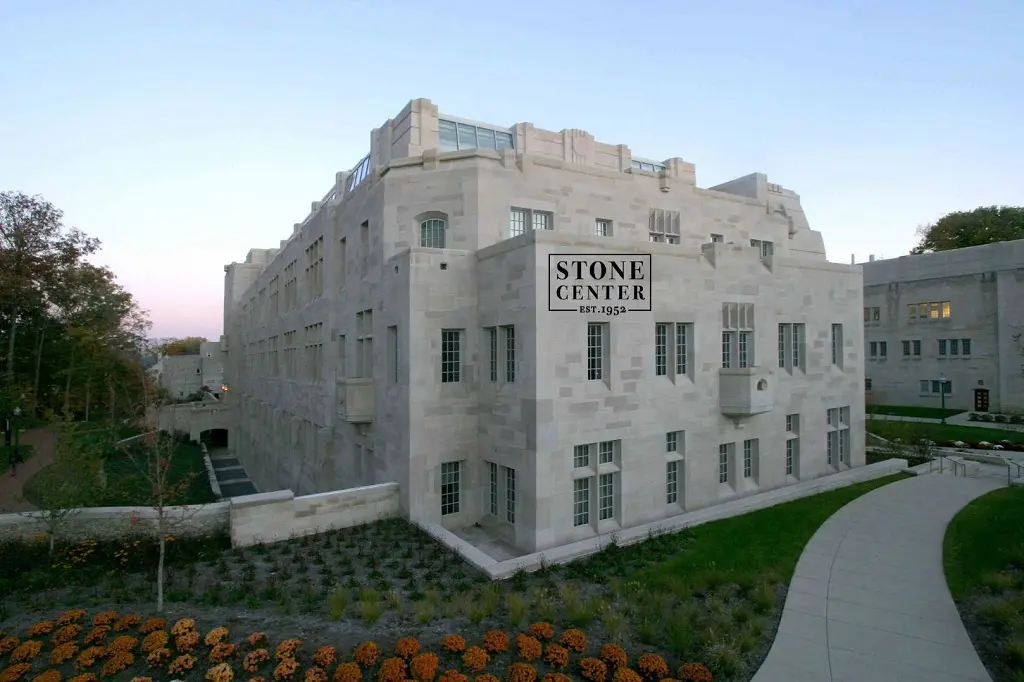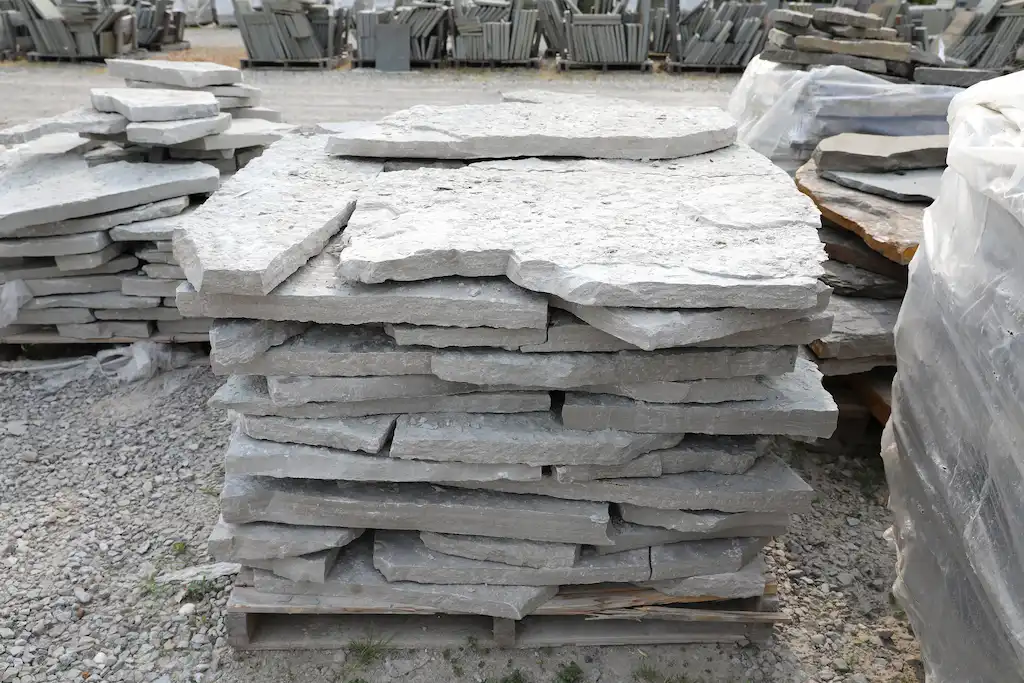- Stone Center
- Blog
Reasons to Choose Natural Stone Pavers Over Concrete Pavers
12/10/2023
12/10/2023
12/10/2023
Reasons to Choose Natural Stone Pavers Over Concrete Pavers
.jpg)
Table of Contents
The first framework to consider when deciding between natural stone vs concrete stone pavers is function over fashion. A suitable hardscape looks good and lasts but also takes practicality into consideration. For instance, frequently used driveways require different pavers to seldom-walked-on paths.
Widely used concrete and stone pavers each have their inherent advantages and downsides. While current technology permits the manufacturing of concrete pavers that mimic natural stone, it still doesn’t outperform it. In this blog, we’ll look at the pros and cons of each paver and why, ultimately, natural pavers stone trumps concrete.
Natural Stone: Pros and Cons
Over millions of years, a combination of heat and intense pressure generated from the earth’s core created natural stone blocks, including granite, marble, limestone, sandstone, and travertine. Natural pavers stone is cut from slabs, which are derived from these massive blocks at stone quarries.
Natural stone is classified into three main categories; igneous, sedimentary, and metamorphic. Stone pavers can come from any of these categories, but the stronger ones are generally granite, limestone, and sandstone used for pavements, patios, driveways, backyards, hardscaping, and landscaping.
The majority of natural stone originates from Italy, Spain, Turkey, Mexico, China, Taiwan, India, Greece, Canada, France, Brazil, and the United States. In fact, Stone Center sources premium limestone from Indiana in the Midwest. Natural stone pavers pricing is on the costlier side, but for many, well worth the upfront investment.
Natural Stone Benefits:
- Eco-friendly
- Each paver is unique in pattern and design
- Low-maintenance
- Can last for decades
Natural Stone Cons:
- More expensive than concrete
- Labor-intensive to install
Concrete: Pros and Cons
Although concrete pavers have been used for thousands of years, it wasn’t until their mass production in the 1940s that commercial utilization exploded. They are made by blending a mix of dry gravel, sand, cement, and coloring agents and then pressing the mixed aggregate into paving stone.
Concrete pavers for patios fall into two categories: interlocking and architectural slabs. The former was invented in the Netherlands after World War II when bricks were in short supply and soon became ubiquitous throughout the world. However, for all their practicality, interlocking pavers lack a natural look as their frozen-oatmeal texture, and plain shapes appear somewhat “boring” and unrefined.
Alternatively, architectural slab pavers offer an attractive alternative. Although these thinner slabs can’t handle vehicle traffic as interlocking slabs do, they are slightly more sensitive to climate and mimic the look of natural stone at less cost.
Concrete Benefits:
- Less labor-intensive
- More affordable
- Can mimic natural stone
Concrete Cons:
- Less eco-friendly than natural stone
- Can crack under heavy traffic and in extreme weather
- Doesn’t last as long as natural stone pavers
- More homogenous look
- Slippery when wet
Why Are Natural Stone Pavers a Better Option?
Concrete Is Less Visually Appealing
Concrete pavers for patios offer less versatility and fewer design options compared with natural stone. While traditional, textured, gray poured concrete is inexpensive and can be stamped, scored, and colored to accommodate different home styles, it still stains and cracks over time, detracting from its visual appeal.
Whether you choose slate, travertine, flagstone, limestone, or bluestone, natural stone pavers offer irregular, earthy charm. Each stone is unique, with deeply ingrained colors that deepen over time. What you see is what you get, and for many homeowners, that’s longevity and enduring appeal.
Natural Stone has a Variety in Styles, Shapes, and Colors
Natural stone pavers are ordinarily made from slate, flagstone, travertine, and limestone, offering an impressive variety of rich and textured earthy hues. Irregular flagstone produces a rugged look with lots of detail, while Indiana limestone pavers offer a polished, elegant, and homogenous look. While artificial slabs can mimic the aesthetic range of natural stone pavers, they don’t compare to the one-of-a-kind beauty of the natural stone.
.jpg)
.jpg)

.jpg)
Unique patterns and designs of each slab can’t be replicated, and as a result, they age far better than their counterparts. Perhaps even more compelling remains the value that natural stone attaches to a property due to its inherent permeability and sustainability. When pavers are used as part of creating a new backyard living space, they offer a resale for a 9% ROI.
Natural Stone Pavers are More Eco-Friendly
When it comes to pavers vs cement, the former beat the latter at environmental sustainability. Stone is a naturally occurring resource; concrete is a man-made material. Because stone pavers don’t need the same level of processing, their carbon footprint is decidedly smaller than concrete.
In addition, the porosity of natural stone allows water to travel through the paver and drain into the ground, which is vital to maintain underground water supplies. Rainwater is an integral part of the water cycle because it refills aquifers. When large land areas are covered with concrete, water cannot permeate the surface, which can adversely affect surrounding flora and fauna.
Natural Stone Pavers Will Age Better
Durability automatically ensures better aging. Natural pavers stone is stronger than concrete and can withstand up to 8,000 pounds per square inch (PSI), while concrete only supports up to 2,500 PSI. Unlike natural stone pavers, concrete can crack under excess pressure, like regular vehicle traffic, for example.
Natural stone pavers tend to preserve their beauty as they age because they contain no composite aggregates or pigment. One of the main issues with concrete slabs is how temperature adversely influences them, whereas natural stone can withstand radical changes in weather without cracking.
Concrete Pavers Require More Maintenance
Everyday maintenance is straightforward with concrete, but repairs can become expensive. If concrete cracks due to extreme weather fluctuations, heavy traffic, or shifting ground beneath it, the whole slab will need to be replaced. Stone pavers have smaller joints, so they’re less prone to cracking and accommodating seed germination.
Although both options are extremely durable, concrete will only last for a good few years, while pavers can withstand decades. In fact, pavers are four times more durable than concrete. Of course, with both, proper maintenance is key to longevity. However, natural stone patio pavers are a more sensible long-term investment.
Conclusion
There’s no right or wrong paver choice, merely preferences and long-term home objectives to consider. In many ways, concrete pavers vs stone pavers is almost an unfair comparison to make. While concrete wins on the short-term price front, natural stone pavers outshine concrete in durability and appeal.
If you spend lots of time in your backyard and are seeking something that reminds you of the outdoors, enhances the natural environment, and lasts, you might consider stone over concrete. At Stone Center, our pavers add the finishing touch to backyard entertainment areas and pathways. Why not browse through our high-quality range of natural stones for landscaping?
FAQ
.jpg)
Jon, the owner of Stone Center, is a knowledgeable expert in natural stone products, specializing in various types of stone for landscaping and architectural projects. Passionate about promoting the beauty and versatility of natural stone, Jon aims to use these blogs to inspire readers with creative ideas to upgrade their homes.








%20(1).jpg)
.jpg)

.jpg)